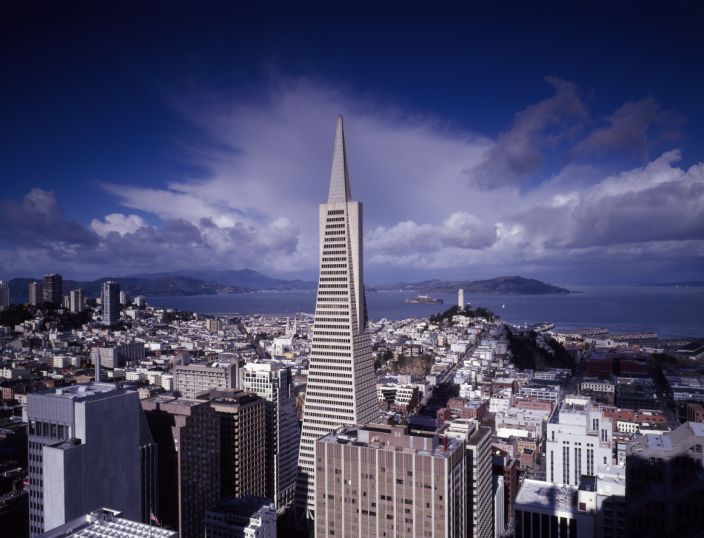The Daily Ten – Transmerica Pyramid sells for $650 million, Bidders circling CoreLogic, WeWork is threatening members, Manhattan landlords taper expectations…

The Daily Ten
1. San Francisco’s iconic Transamerica Pyramid sells for $650M, the largest US commercial real estate transaction post-COVID-19 | Yahoo Finance
One of the most iconic skyscrapers in San Francisco, the Transamerica Pyramid Center, has officially sold, marking the largest commercial real estate transaction in the U.S. since the COVID-19 outbreak.
A joint venture led by New York real estate investment firm SHVO and Deutsche Finance America closed their acquisition of the Transamerica Pyramid on Wednesday.
The group paid $650 million for the 48-story tower and complex that spans an entire block and includes three buildings totaling 750,000 square-feet in San Francisco’s Financial District. A group of European investors anchored by Bayerisch Versorgungskammer also participated in the deal.
2. Real estate fintech CoreLogic receives multiple potential bids at more than $80 a share, sources say | CNBC
Property data and analytics firm CoreLogic has received multiple potential takeover bids that value the company at north of $80 a share, sources tell CNBC’s David Faber.
The multiple parties interested in pursuing a deal with CoreLogic include private equity firms, Faber reported citing sources familiar with the talks. The company has already signed a non-disclosure agreement with at least one potential buyer, the people said.
CoreLogic confirm later on Wednesday that it is “engaging with third parties indicating preliminary interest based on public information in the potential acquisition of the Company at a value at or above $80 per share.”
3. Manhattan Bosses Pull Back Expectations for Return-to-Office | Bloomberg
New York’s technology and finance bosses are tempering their expectations for bringing people back to work.
Only 15% of office workers are projected to return by the end of this year, according to the Partnership for New York City, which surveyed major employers in Manhattan over the past two weeks. That’s down from an August estimate of 26%.
Tech employers see 49% of workers coming back by July 2021, compared with 74% in the August survey, while finance and insurance companies see 52%, down from 55%.
New York’s biggest landlords and finance executives have been vocal about bringing office workers back this fall, with some even calling it the patrioticthing to do to boost local businesses. But most companies remain cautious as the virus continues to spike in many places, and it’s unclear whether a vaccine will be widely available anytime soon.
4. Outrider raises $65 million to make warehouses and distribution centers autonomous | Venture Beat
Autonomous logistics startup Outrider today closed a $65 million funding round led by Koch Disruptive Technologies. Outrider says the funds will be used to accelerate go-to-market efforts as it expands its workforce to over 110 employees and grows its customer base of Fortune 500 companies.
Driverless vehicle technology has already begun to transform industries. TuSimple, Einride, and others have raised tens of millions for freight systems that transport logs, shipping containers, and other cargo autonomously. Some experts predict the coronavirus outbreak will hasten adoption of autonomous delivery solutions. Despite the public’s misgivings about self-driving cars and their need for regular disinfection, the vehicles promise to minimize the spread of disease by limiting driver-rider contact.
5. WeWork’s New CEO Is Eyeing an IPO Again — After He Turns Profit | Bloomberg
WeWork is on track to turn profitable in 2021 and will then revisit plans for an initial public offering, Chief Executive Officer Sandeep Mathrani said, a year after the startup’s IPO fiasco prompted the ouster of his predecessor.
The office-sharing startup renegotiated leases, laid off staff and replaced management after Japan’s SoftBank Group Corp. took control. The business is bouncing back “100%” in certain Asian markets, including China, South Korea and Singapore, Mathrani told a small group of reporters in India on Wednesday.
“I’m a big believer in one step at a time so let’s hit profitable growth first, and we’ll then revisit the IPO plan,” Mathrani said over a Zoom video conference call from New York. “Nazar na lag jaye,” he added, a Hindi expression to convey he didn’t want an evil eye cast on WeWork’s turnaround strategy.
6. Disneyland Paris building one of the largest solar canopies in Europe, will span 42 acres | Fox Business Network
The plant is slated to open in 2023
Disneyland Paris is focusing more on its eco footprint and undertaking one of the largest solar canopy builds in all of Europe.
The theme park made the announcement last week on “World Energy Day,” sharing its plans to build a solar plant that will be able to power 17% of the resort – equivalent “to the annual energy consumption of a small city” – with renewable energy.
The plant will take up 42 acres, using 67,500 solar panels. Together, it will lead to a reduction of more than 750 tons of CO2 per year, according to Disney’s blog.
7. A city offers harsh lessons after emerging from one of the world’s longest lockdowns | Fortune
As countries across the globe grapple with the prospect of renewed lockdowns, the Australian city of Melbourne offers a stark lesson on the costs of bringing the coronavirus under control.
The city of 5 million people on Wednesday emerged from one of the world’s strictest and longest lockdowns that shuttered businesses and confined residents to their homes for more than three months.
While infections have dropped from a daily peak of about 700 in early August to just two new cases on Wednesday, the economic and social impact of Melbourne’s second lockdown since the crisis began has been enormous. Australia’s government estimates 1,200 jobs have been lost on average a day across Victoria state, while demand for mental health services has surged by more than 30%.
8. Young and Jobless in Europe: ‘It’s Been Desperate’ | The New York Times
The pandemic-induced jobs crisis has fallen disproportionately on generation Covid-19, and the effects may be long lasting.
lise Prevost in her Paris neighborhood, Montmartre, which is normally full of tourists.Sabine Mirlesse for The New York Times
Like millions of young people across Europe, Rebecca Lee, 25, has suddenly found herself shut out of the labor market as the economic toll of the pandemic intensifies.
Her job as a personal assistant at a London architecture firm, where she had worked for two years, was eliminated in September, leaving her looking for work of any kind.
Ms. Lee, who has a degree in illustration from the University of Westminster, sent out nearly 100 job applications. After scores of rejections, and even being wait-listed for a food delivery gig at Deliveroo, she finally landed a two-month contract at a family-aid charity that pays 10 pounds (about $13) an hour.
“At the moment I will take anything I can get,” Ms. Lee said. “It’s been desperate.”
9. WeWork tells members you must pay rent | The Real Deal
Office-space provider sent hundreds of letters to members unable to pay and has threatened some with debt collection, according to a report
WeWork has doubled down on its demand for rent from members unable to pay, in some cases threatening debt collection if clients don’t fork over the money.
Covid-related eviction moratoriums in many cities, including New York, have been extended, offering some relief to commercial and residential tenants. But WeWork has memberships, not leases so it doesn’t have to abide by those moratoriums.
The office-space provider is now taking a tougher stand with members unable to pay rent, according to Business Insider. It sent hundreds of letters from in-house lawyers to members in the U.S. and Canada, demanding rent, according to the report. About 100 letters were sent from outside attorneys to members with higher outstanding balances.
10. Tiny Brain Implants Hold Big Promise for Immobilized Patients | WSJ
Neuroscientists see unmet demand for technologies that detect and translate neural signals to help people with mobility problems
When Phil O’Keefe wants to open a document or click a link on his computer screen, he can think about tapping his left ankle.
That brain activity is collected by sensors implanted in a blood vessel in Mr. O’Keefe’s brain and relayed to a computer through devices in his chest. The signals are converted to a mouse click or zoom-in on his screen with the help of machine-learning software.
Mr….

